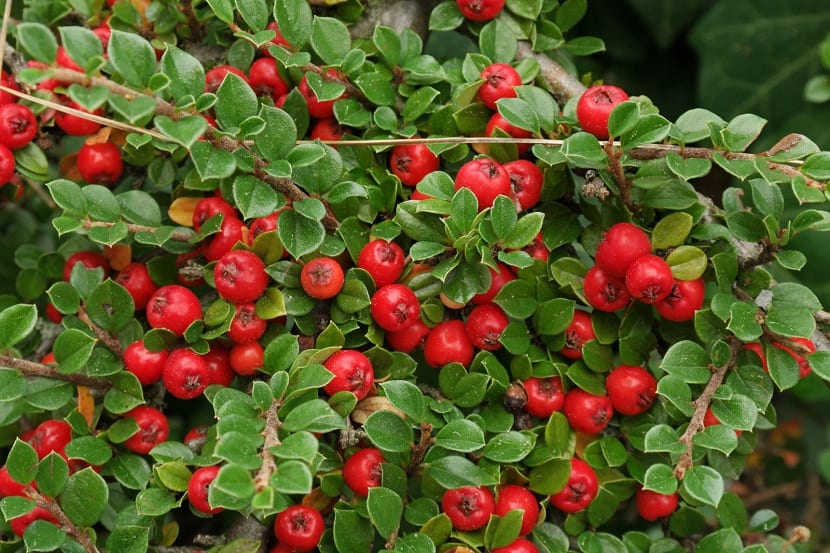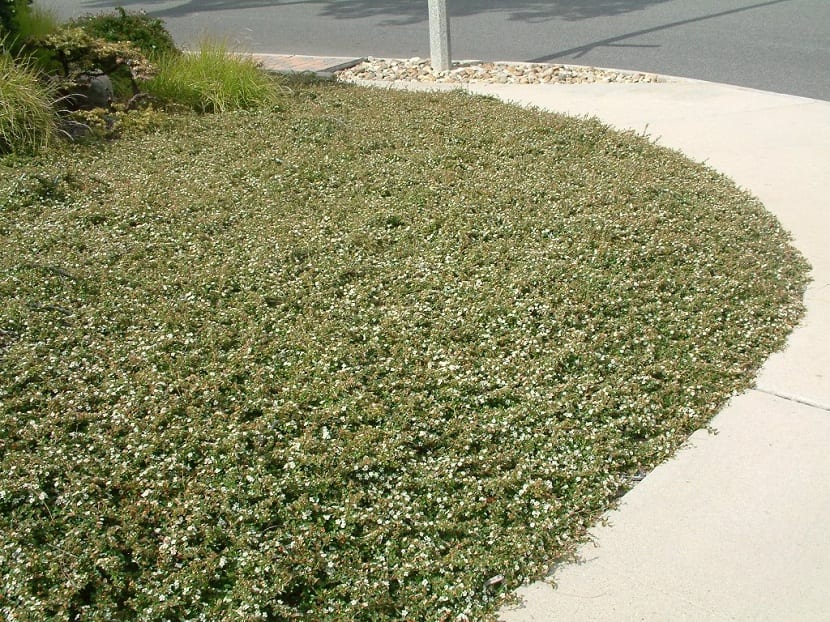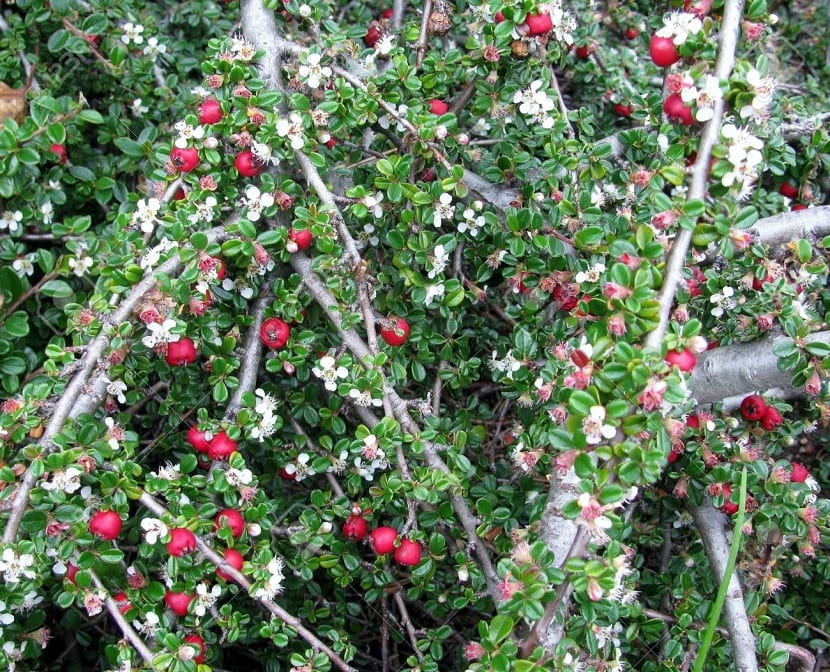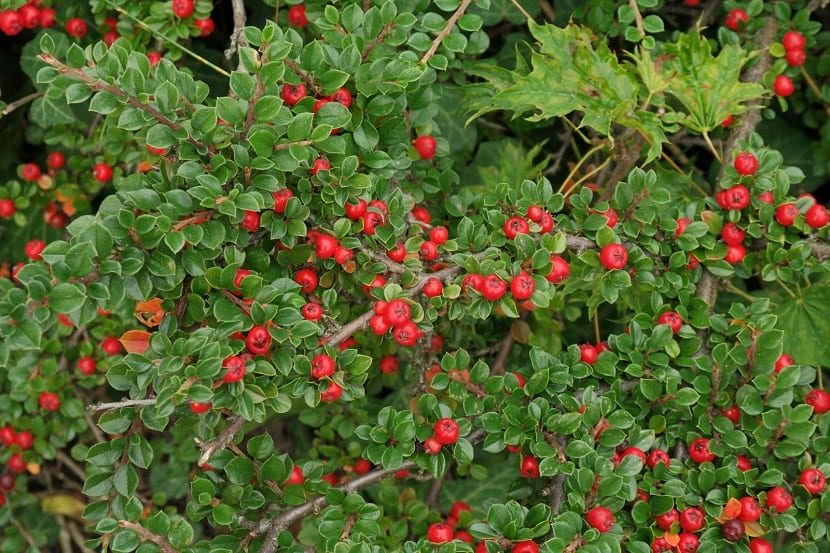
We are going to talk about a bush with berries and whose coloration is autumnal. It's about the bush Cotoneaster dammeri. It is a plant native to Asia and its appearance is that of a covering plant. It usually reaches its maximum size quickly. Therefore, it is an excellent plant to cover the less populated areas of the garden. It is ideal to use and fix on slopes.
In this article we are going to tell you all the characteristics of the Cotoneaster dammeri and what care you need.
Key features

This shrub has persistent and small leaves with an oval shape and bright color on the upper side and light green on the underside. Most of the flowers are produced in spring and are white. The fruits, however, are not accompanied by flowering, but are produced in autumn and are orange in color. This is the reason why this type of shrub is said to have berries for autumn appearance.
The leaves are evergreen so we will see them throughout the year. Even in autumn this plant does not need to be pruned. This makes the care and maintenance of this species much less than that of other shrubs. One of the advantages of having this plant in the gardens is that they attract birds and, therefore, it helps to maintain the fauna and the reproduction of the rest of the plants.
The roots of Cotoneaster dammeri they are quite normal. They are not very deep and do not have to be controlled in their growth. They are suitable for most locations where you can see other plants around you that will not compete for nutrients. Obviously, being a shrub, it is not adapted for interiors or closed spaces. Its location must be outdoors.
Requirements of Cotoneaster dammeri

This type of shrub adequately withstands low temperatures down to -12 degrees. This makes it a perfect plant to have in areas with cold climates. If the care is correct, this plant is not usually sensitive to different common garden pests. If we neglect it, if it can suffer from some plague.
As for the substrate, it works on numerous types of substrates. It is correct for substrates that do not have many nutrients. It can grow in poor and sandy soils, but in those sandy soils we usually see a high proportion of sand and it does not conserve water very well. For this reason, in these types of soils the cultivation of plants is usually more complicated and a greater imprecation technique is needed for irrigation. The good thing about this type of soil is that species that need good drainage adapt quite well. This shrub can adapt to dry soils that are more infertile and have a low capacity to retain water.
It is also suitable for use on damp soils. These soils tend to store all types of moisture near them. Normally, in this type of soils it is more difficult to evacuate the water so irrigation should be more moderate. Some plants cannot support this type of soil because they cannot withstand excess water.
Cotoneaster dammeri it can be sown in fertile substrates. If these soils are properly fertilized and have a high amount of nutrients, we will be able to see greater growth from the flowers and leaves. It can survive in heavy substrates such as clayey or robust soil or as porosities where cultivation is more difficult. These soils are those that should and crack preventing the roots from growing normally. Therefore, this type of flooring is more difficult to work with.
It is ideal to be used in rockeries, to form massifs, on slopes, etc. This is due to their care is quite low. We can also use it in pots and it will offer a kind of waterfall of green.
Caring for the Cotoneaster dammeri

For we are going to take into account the care that this plant needs to be able to grow correctly. The first thing to consider is the location. Although it is capable of withstanding the cold and low temperatures, it requires a location in full sun. It is capable of surviving semi-shade or even shade, but it is not the most ideal. The soil has to be fertile and deep even though it is able to survive in other types of soil. It tolerates acidic, basic and neutral soils, so we will not have problems with the pH.
As for watering, it should be moderate in winter to increase during the summer time to a couple of times a week. All this also depends on the type of soil where we have it planted. If we have a soil where the drainage is quite good, we will have to water more frequently. On the other hand, if the soil is wet, we should not water as often since it is capable of maintaining a certain degree of humidity all the time.
It is not necessary to prune itself. You can only cut those branches that are drying so that they can grow more vigorous. When it comes to reproducing them, we can do it in two ways. We can multiply them by cuttings and by their small roots that are found in the branches. These roots can be acquired as the plant develops through the soil.
Curiosities

As we have mentioned before, this plant can be placed in small pots and with little funds to go pruning the roots and branches of the plant. In this way we will get a bonsai. Another interesting thing that can be done with this plant is to cut a few branches that have the red fruits and place them in a vase to decorate our home.
This plant is ideal to have in gardens since it does not need much care. In winter it can survive perfectly with the rainwater as long as we do not have a very dry or hot climate. We must remember that, although this plant should be in full sun, it is ideal to protect it during times when the sun is more intense.
I hope that with this information you can know more about the Cotoneaster dammeri.